C. Raymond Hunt, and internationally known and respected helmsman and yacht designer. A gifted visionary, with an innate sense of the physics of motion. To his peers he was a man “ahead of his time” To his competitors, through his creation of the deep-V hull, and the radical international 110, the preeminent forefather of Hunt’s 10 series of yachts, he was feared on the race coarse.
James H. “Sham” Hunt, on his fathers 10 Series, “I have sailed on all…like the way the 110 goes through the water the best but a bit wet and pounds in a sea way…..the 510 was very quick, CRH and my mother won their share at Edgartown Regatta and the NYYC cruise. My favorite would be the 210…I am 6’2 so the 110 was very cramped for me whereas the 210 had comfort in comparison.”
For the complete biography on C. Raymond Hunt, there is the first and only biography in the works and will be offered for sale soon. Mark W. Kellogg, the author of the soon to be released Raymond Hunt biography is a long time Marbleheader, who in his youth, drove a 21-foot Huntform launch named “Cabby” as a nautical taxi, taught sailing in Hunt-designed 110s, was a paid hand on two Concordia’s, and raced with Ray Hunt in John Mooney’s Hunt-designed 5.5 Meter, “Minotaur.”
THE “ONE-TEN”
In 1936 Raymond Hunt along with engineers Bror Tamm and Gordon Munro decided to build a 36’0″ prototype at the Lawley Yard in Neponset, Masachusetts. Although there were doubts about her potential sailing abilities, she quickly proved doubters wrong. But, at the time, no one seemed to want one, the prototype was too peculiar, and slab-sided for her size.
After much thought and consideration the Raymond Hunt brain trust decided to scale down the 36′ prototype twelve feet. The new yacht was called the International 110, and with it a new era in yachting was ushered in.
After the 1938 Hurricane “A Wind To Shake The World” yacht construction prices were skyrocketing. Through Hunt’s association with Lawley’s, Raymond began experimenting with a new boat building material Harborite Plywood. The miracle overlayed fir plywood, offered “Armor Plate” protection with two tough, abrasion resistant surfaces of plastic resin impregnated fibres that are permanently welded together, creating a seamless easy, and cost effective way to build a boat. The 110 was built with four 12 foot sheets of Harborite laid over laminated oak frames and would use a simple rig with a rated sail area of 110 square feet, hence the name.
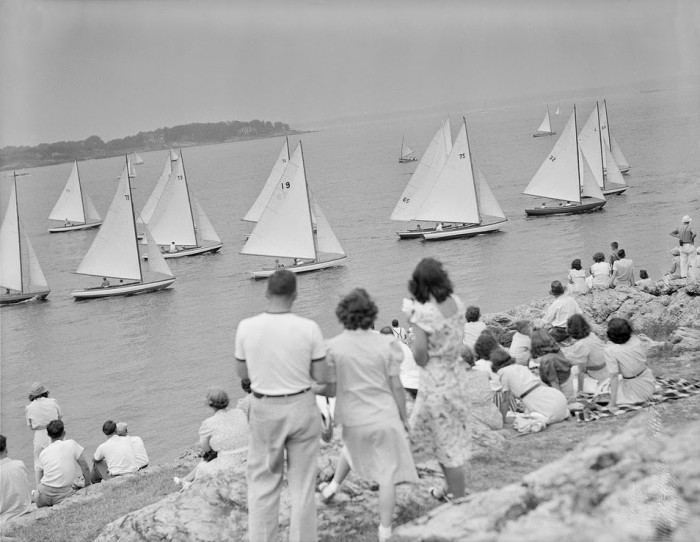
The International 110 was introduced at the 1939 Marblehead Race Week Regatta. Ray Hunt raced the boat around the coarse beating everyone boat for boat except the International One Design. With a price of $480.50 with sails the demand for this vessel began in earnest.

Ray Hunt would forever change the sailing world, hundreds of his new 110 design were being delivered as fast as they could build them. Unheard of for the time period, where other ship yards at best were producing 6-8 yachts a year, there were over 400 hulls built in a two year time period. Today as true testament to Hunt’s abilities, the 110 is still in production, and recently the class celebrated its 75th anniversary in Marblehead, Massachusetts, the place where things all began in those depression years prior to World War II.
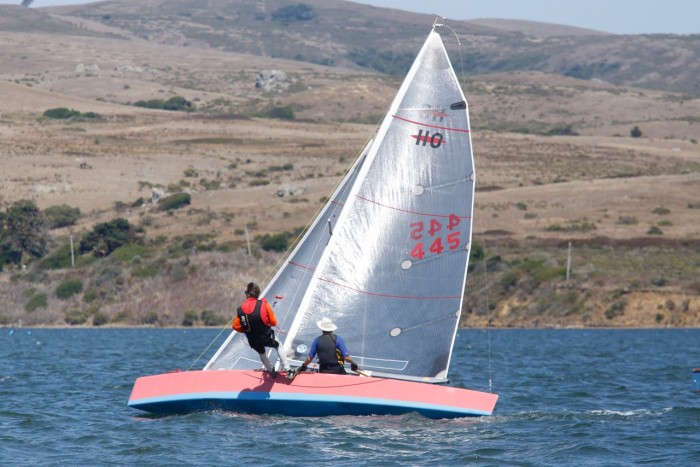
Other innovations that were invented and used first on the Lawley 110 was the trapeze system, and the “Clewouthaul” – which was designed by Bror Tamm in 1939 . The one ten was a radical departure from the yachts of its day, they were unique and iconic in the harbors there were used in. They were the forefathers of today’s ultralight sport boat concept.
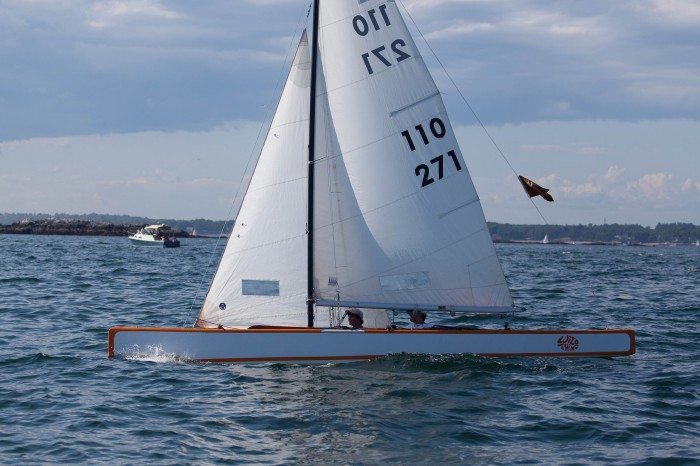
Through the initial aesthetic development of the 110, it was believed that painting the hull in such a way that would accentuate the roundness of the edges was absolutely necessary, if the shape of the hull is to look well. The new painting schedule was encouraged, but was often overlooked, in favor of more budget friendly all in one color paint scheme.
The Internation 110 is still in production, the current builder is Westease Yacht Service, Inc., 66th St & 135th Ave N, Saugatuck, MI 49453, Phone: (616) 394-0076. There are active racing fleets across the US in Maine, Massachusetts, Rhode Island, Connecticut, New Jersey, Illinois, Michigan, California and Hawaii.
International 110 Specifications:
LOA: 24’0” / 7.3m
LWL: 18’0″ / 5.5m
Beam: 4’0” / 1.2m
Draft: 3’0” / 0.91m
Displacement: 910 lbs
Ballast: 300 lbs
Designed: C. Raymond Hunt
Hull material: “Harborite” Plywood Construction
Original Contract Cost: $480.50
Sail Plan: Main, Jib, Spin
Spinnaker: Conventional
Upwind sail area: 157 sq ft
Spinnaker sail area: 100 sq ft
Mast Height: 23’0″
Crew: 2
In production: Yes
Class Website: International 110 Class
Approximate number built: 750+
THE “TWO-TEN”
The International 210 was drawn by Fenwick Williams, under the guidance of C. Raymond Hunt. Designed to be a bigger drier boat than the 110s. Mr Hunt built a prototype in the Spring of 1946, which was presented to the clubs of Massachusetts Bay for consideration as the selected boat for inter-club racing. The requirements of the clubs were that they wanted a new one design boat that was affordable, pleasant for day sailing as well as racing, a boat that will always be uniform so that it cannot be out-built. ‘Fourth a boat that is modern and can be kept so. At the next meeting, the selection committee announced that Ray Hunt’s proposed “210″ was more boat than any other that the clubs could find for the money, so they adopted it, and with it a new era in yachting was ushered in.

True to the 210s origins through good price, comfort, and exceptional racing abilities, the class took off with some of the sports top sailor’s campaigning boats throughout Massachusetts Bay. Soon fleets were formed throughout the Midwest, Maine, Hawaii and beyond.
Governed by strict one design class rules, to keep boat costs down, but allowing for nominal changes to keep up with the times, a successful concept for the development of the class, yet challenging at times.
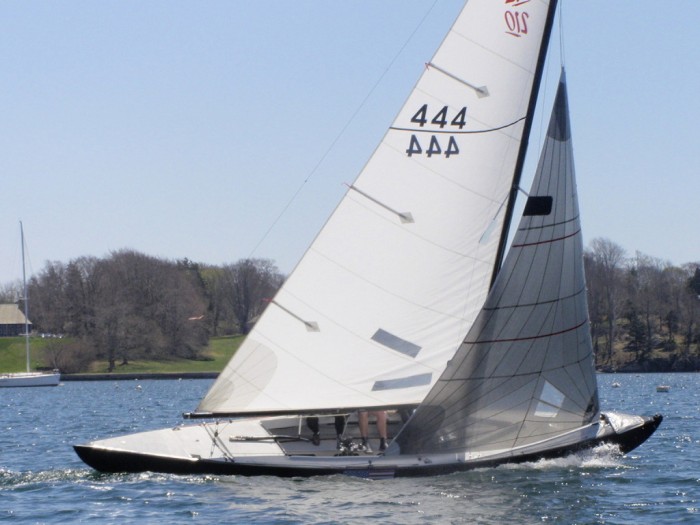
The International 210 is currently in production at Shaw Yacht’s, Inc., 52 Oyster River Road, Thomaston, ME 04861, Phone: (207) 594-5035, Fax: (207) 594-5035
International 210 Specifications:
LOA: 29’10”
Beam: 5’10”
Draft: 3’10”
Ballast: 1,175 lbs
Displacement: 2300 lbs
Designed: C. Raymond Hunt
Sail Plan: Main, Jib, Spin
Spinnaker: Conventional
Upwind sail area: 305 sq ft
Spinnaker sail area:
Hull material: Double Curvature 3/8 “Harborite” Plywood bent over laminated oak frames.
Crew: 3
Original Contract Price: 1,275 – 1,500 w/o sails
In Current Production: Yes
Class Website: International 210
Approximate number built: 462

THE “THREE-TEN”
As of this writing, not much is known about the 310
THE “FOUR-TEN”

James H. “Sham” Hunt on sailing on the International 410 Et Toi – “CRH and I only..age 13…raced in the New London to Marblehead Race in 1949 and won by such a large margin that the committee called the Canal to see if we had taken a short cut through it..no of course….this was when you had to check in before any transit was allowed! I doubt I added much but he had such stamina that a 24 hour vigil was a piece of cake.”
Thames Yacht Club members considered the International 410 “Nor’wester” – “A stylish double-ender, one of the most beautiful boats to ever grace the club fleet. Under sail or bare-poled at her mooring, she always drew comments from people impressed with her near-perfect lines.”
In the Fall of 1961, during the Off Soundings Club Regatta, Nor’Wester’s 4th owner, Charles LaCour and his three member crew were enjoying a comfortable lead with two other boats, they were way ahead of the rest of the fleet. Under full main and small jib with 20-knots of breeze, they were approaching Shagwong Reef buoy off Montauk Point, when a strong squall approached out of nowhere knocking down Nor’wester. A huge swell then filled the non-self-bailing cockpit, and within minutes the boat sunk. The entire crew were picked up and brought to Shelter Island, New York, their final destination point of the first day’s race. That night, still shaken by their ordeal, they returned back to New London, on the Orient Point Ferry.
Anemometer readings, from Montauk Point had clocked gust up to 79 miles per hour. NorWester had sunk in 55′ of water, with strong currents, LaCour decided not to salvage her, figuring reluctantly that they would be unsuccessful in there attempt to raise her.
Later that year, the Off Soundings Race Committee, mandated that all entries had to have self-bailing cockpits. The tragedy influenced the implementation of the Safety of Life at Sea (SOLAS) laws that generated numerous maritime safety rules still in effect today.
Ownership History:
1947 – Et Toi – Ray Hunt
1950s – Nor’wester – Lawrence Chappell, Jr (joined the Thames Yacht Club Fleet)
1950s – Nor’wester – Ray Camp Norwich
1960 – Nor’wester – Charles M. LaCour
Known Racing History:
1952 – Thames Yacht Club Distance Race – First boat to finish and corrected time winner.
1949 – Off Soundings Race – (Lawrence Chappell) Spring and Fall – 1st and 2nd place respectively
1948 New London – Marblehead Race (Ray Hunt) Et Toi beat the nearest competitor by 2 hours.
The 410 “Nor’wester” Specifications:
LOA: 35’10 7/8″
LWL: 28’3″
Beam: 6’10 3/4″
Draft: 5’9″
Ballast:
Displacement:
Designed: C. Raymond Hunt
Built By: Marblehead Yacht Yard
Year Designed:
Year Built: 1947
Sail Area: 482 sq ft
Hull material: “Harborite” Plywood Construction
Original Owner: Ray Hunt
Original Name: Et Toi
Sail Plan: Main, Jib, Spin
Spinnaker: Conventional
Upwind sail area: sq ft
Spinnaker sail area:
Crew:
THE “FIVE-TEN”
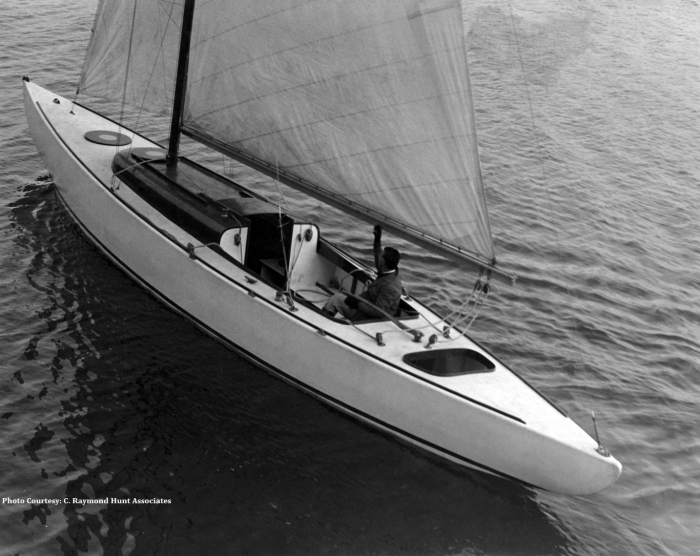
C.Raymond Hunt “In 1945, I designed the original “510” class yacht for myself as a logical development of the “210”.
Launched in December 1945 as a racing and weekend cruising yacht. She is built with no structural keel, and is constructed with two longitudinal trusses on oak floor stiffeners extending to the after end of the cockpit to the mast evenly distributing the stresses of the rig and keel.
Low wetted surface area with a separate rudder-skeg / bulb fin keel, a concept Raymond Hunt embraced long before Lapworth or Giles, should prove to be a spirited performer, with comparable speeds of 8 meters and Q-boats.
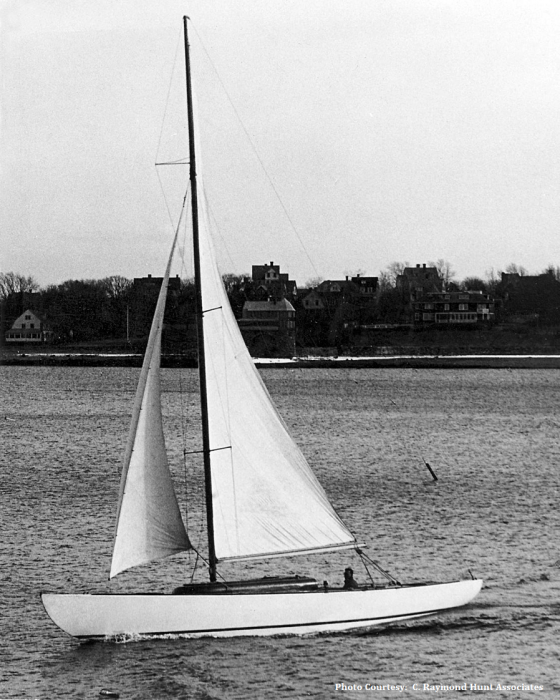
Known Racing History:
1949 – NYYC Cruise – Beat the 72’0″ Yawl “Bolero” boat for boat, with Raymond Hunt and his wife sailing against a full paid professional crew on board “Bolero”
Historical:
The one and only 510 built, named after Raymond Hunt’s wife Barbara.
Hunt International 510 “Barbara” Specifications:
LOA: 44’7″ / 13.62m
LOD: 44’7″ / 13.62m
LWL: 32’6″ / 9.93m
Beam: 6’7″ / 2.04m
Draft: 6′ 0 / 1.82m
Ballast: 5,200 lbs Galvanized steel plate/lead casting
Displacement:
Sail Area: 519 sq ft
Yard Number:
Hull material: “Harborite” Plywood Construction
Rig: Sloop
Designer: C. Raymond Hunt
Built by: Graves Yacht Yard
Year Designed: 1945
Year Built: 1949
Original Contract Cost: $6,000
Restored By:
Current Name:
Original Owner: C. Raymond Hunt
Current Owner:
Sail Number: 510/1
International 510 Revisions (March 27, 1975)
In 1975 C.J. Frankham, esq, Aukland, New Zealand wanted a inexpensive high performance owner operated yacht and decided to have CR Hunt and Associates revise and update the 1945 drawings of the 510 class yacht that Ray Hunt built for himself. The design of the hull was left basically unchanged, but the sailplan was updated. The main was increased 35 sq ft to 335.8′ P = 39.5′ E = 17′ and the jib was increased to measure 215 sq ft I = 37.5′ J = 11.5′ The accommodations were also updated to include 2 berths and settees with a head and small galley located in the companionway for the additional headroom.
Also Modified from the original boat is the deck plan. A self-bailing cockpit replaces the split-cockpit arrangement. The Interior plan, that accommodates 4 people, has been changed to suite the owners requirements.
Although the 510 design was revised for construction to occur in New Zealand, it was never finished. A reported fire in the barn which housed the owners business and the 510 under initial construction were all lost.
Specifications:
LOA: 43’1″ / 13.13m
LOD: 43’1″ / 13.13m
LWL: 32’6″ / 9.93m
Beam: 6’7″ / 2.04m
Draft: 6′ 0 / 1.82m
Ballast: 5,600 lbs / 2545kg
Displacement: 6,900 lbs / 3136kg
Sail Area: 551.4 sq ft / 51.2m2
Disp/Length Ratio: 90
SA/Disp Ratio: 24.4
Design Number: CRH – 510
Hull material: “Harborite” Plywood Construction
Rig: Sloop
Designer: C. Raymond Hunt Associates, 63 Long Wharf, Boston, MA
Built by:
Year Redesigned: March 27, 1975
Year Built: Never Completed
Contract Cost:
Restored By:
Current Name:
Original Owner: C.J. Frankham, esq
Current Owner:
Sail Number:
International 512 (Company Offered) Revisions (2010?)
LOA: 43’1″ / 13.13m
LOD: 43’1″ / 13.13m
LWL: 31’11” / 9.48m
Beam: 8’0″ / 2.43m
Draft: 6′ 0 / 1.82m
Ballast: 5,600 lbs
Displacement: 6,900 lbs
Sail Area:
Design Number:
Hull material:
Rig: Sloop
Designer: C. Raymond Hunt Associates
For Inquiries: Hunt Yachts
Built by:
Year Designed: 2010?
Year Built: Offered for Spec
Contract Cost:
Restored By:
Current Name:
Original Owner:
Current Owner:
Sail Number:
THE “TEN-TEN”
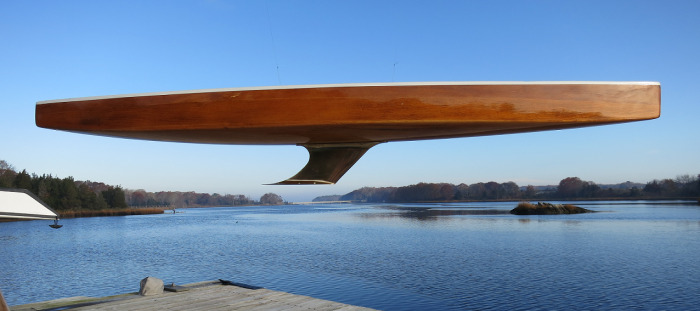
Briggs Swift Cunningham II (January 19, 1907 – July 2, 2003), American sportsman, entrepreneur, and heir to the Proctor & Gamble fortune. Was an accomplished car and yacht racer, having been inducted into the America’s Cup Hall of Fame in 1993, the Motorsports Hall of Fame of America in 1997, and named to the International Motorsports Hall of Fame in 2003. Skipper of the first AC campaigned 12 metre yacht “Columbia” due to Cornelius Shields health concerns. Cunningham and his afterguard won the 1958 America’s Cup race in four straight races off Newport, R.I., each time with a margin of victory of no less than half a mile.
“Mr. C” was an accomplished Star, and 6 metre class sailor, having won numerous races world-wide. By early 1939, having sold Lulu, Fun and Lucie, left Briggs Cunningham without a six-meter for the first time in ten years, at this time Cunningham ordered sailed and raced his C. Raymond Hunt “Lawley 225” out of the Pequot Yacht Club, Southport, Connecticut.
In 1959, through Briggs Cunningham’s long association with C. Raymond Hunt, he decided to have a new yacht designed and tank tested. According to James H. “Sham” Hunt, Mr. Cunningham, “wanted a 110 type boat long enough to beat a 12 meter.” Briggs Cunningham funded the project, “the tank test results came back and said there was too much leeway so the quest ended but later the tank test results (were reevaluated) and said they made an error by not taking into account that the chines on healing gave the necessary force!!!!! the boat would have trounced a 12!”
Hunt designed 1010 Known Specifications:
LOA: 55’0″ / 16.76m
Beam: 8’0″ / 2.43m
Year Designed: 1959
9″ of bottom curve at mid section
*Note: The keel bulb is missing on the model. Being detachable it allowed CRH to test iterations.
REFERENCES:
James H. “Sham” Hunt (Son of C. Raymond Hunt)
CREDIT:
C. Raymond Hunt Associates – Website
1:12 scale 1010 Tank Test Model: Courtesy of James H. “Sham” Hunt
Photo credit – James W. Laws Photography
Photo credit – A. Mitchell Koppelman
Photo credit – Blake Jackson – MarbleheadStudios.com
Letters/Brochure – Courtesy of Bill Platt


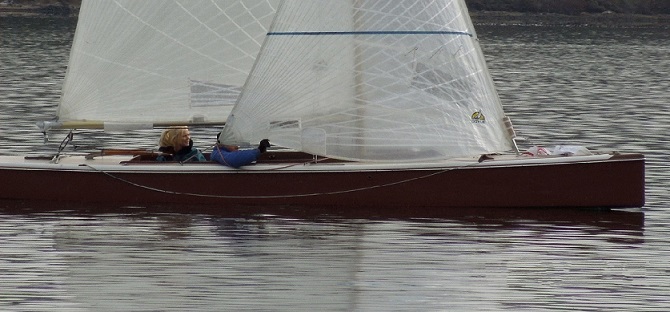

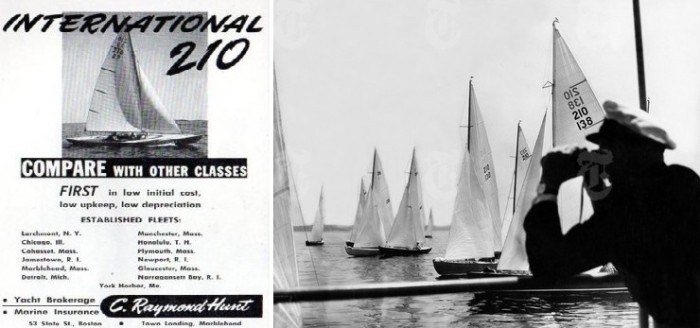
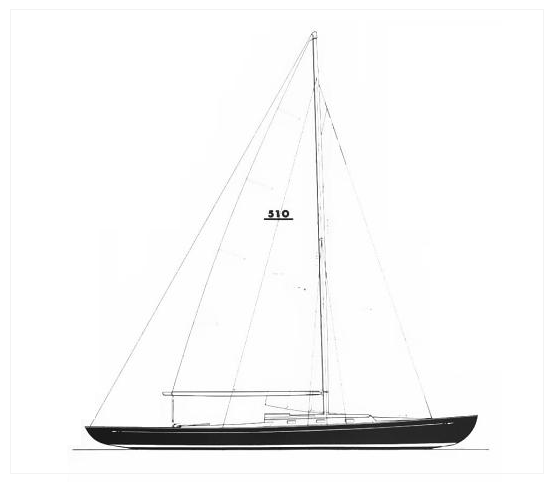
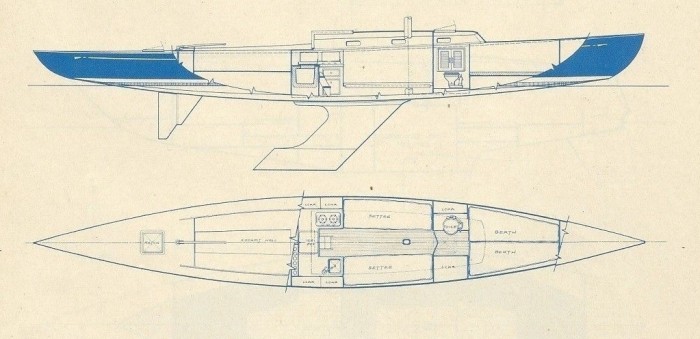
Fascinating information on C. Raymond Hunt’s “Ten Series” yachts. What a gift he made to yacht racing and cruising!
Sailed many times aboard 510 Barbara as a child 1950s. My father had bought her from Bob Pierce of Duxbury. Sure would like to know where she is now.